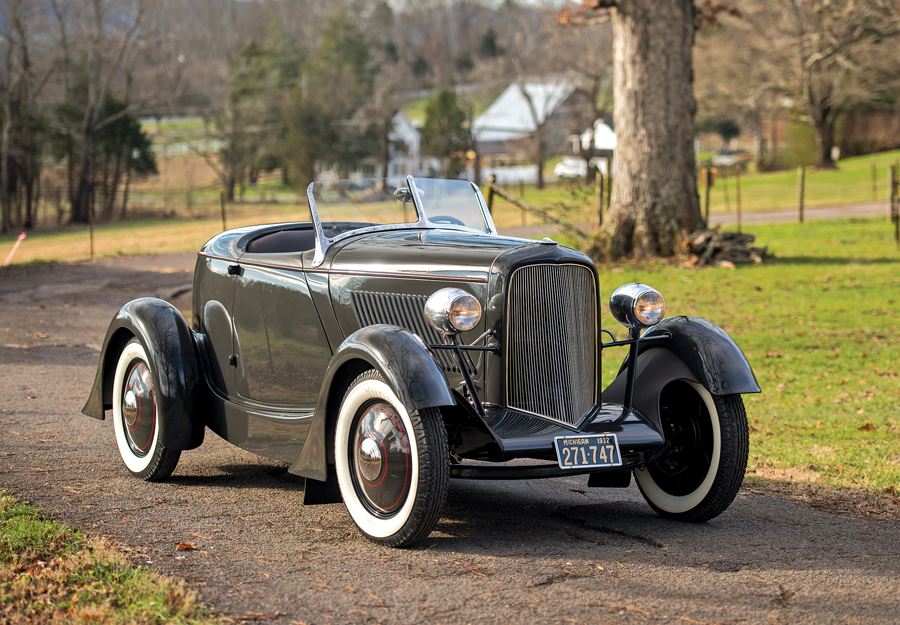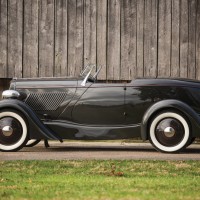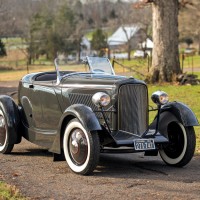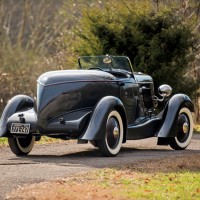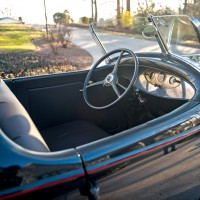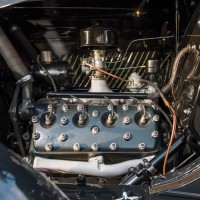- The first of three one-off custom speedsters built for Edsel Ford
- Designed by E.T. “Bob” Gregorie and constructed by Ford Aircraft Division
- Amelia Island Concours d’Elegance major award winner
- A highly significant landmark of Ford history and design
- Offered for the first time in over 70 years
SCM Analysis
Detailing
| Vehicle: | 1932 Ford Model 18 Edsel Ford Speedster |
| Years Produced: | 1932 |
| Number Produced: | 6.893 DeLuxe V8 roadsters (Plus 520 Standard V8s) |
| SCM Valuation: | As this is a one-of-one car, the median and high sales are the same — $770,000 |
| Tune Up Cost: | $250 |
| Chassis Number Location: | On frame rail in front of firewall on driver’s side |
| Club Info: | Early Ford V-8 Club of America |
| Website: | http://www.efv8club.com |
| Alternatives: | Other ’30s-era custom cars |
| Investment Grade: | A |
This car, Lot 162, sold for $770,000, including buyer’s premium, at the RM Sotheby’s Amelia Island, FL, auction on March 12, 2016.
Edsel Bryant Ford was the President of Ford Motor Company from the age of 25 until his untimely death on May 26, 1943. But his father (and company founder) Henry Ford still called the shots.
A mechanically clever farm-boy-turned-inventor who literally put America on wheels with his simple, practical — and efficiently mass-produced and affordable — Model T, Henry Ford was shrewd, idiosyncratic — and sometimes cruel. Henry Ford ruled over the more gentle and artistic Edsel, and retained a cadre of loyal bullies to ensure that Ford Motor Company ran his way.
Nonetheless, Edsel Ford managed to exert considerable influence, first on the styling of early Lincolns, and then on milestone cars such as the 1928 Model A, the 1932 Ford, and many models that followed, including the Lincoln-Zephyr, the first Mercury Eights, and the original Lincoln Continental.
A consummate enthusiast with an elegant flair for design, Edsel drove a succession of interesting cars, from modified Model T speedsters to a Stutz, a Bugatti and a Hispano-Suiza.
Edsel was an accomplished fine artist, and he studied painting all his life. He had a particular interest in the look of Ford cars — an issue that did not much interest his puritanical father.
Ford Motor Company’s no-frills styling emanated from the engineering department. So Edsel formally set up Ford’s first styling group in the spring of 1935, and he chose Eugene T. “Bob” Gregorie to lead the team. Gregorie, who had worked as a yacht designer, at Brewster & Company and at Harley Earl’s GM Art and Colour Section, was an accomplished sketch artist who deftly translated Edsel’s visions into reality.
A trio of sexy Speedsters
Edsel and Gregorie began their collaboration early in 1932 — even before Ford’s styling department was formally established. After Edsel returned from a 1932 European trip, he asked Gregorie to design and supervise the construction of a sports car similar to those he’d seen on the Continent.
Gregorie’s excellent drawings captured Edsel’s ideas. Gregorie also could skillfully translate concepts from two to three dimensions.
Edsel wanted something “long, low and rakish.” Although that was a challenge on the 1932 Model 18’s stubby 106-inch wheelbase, Gregorie designed a jaunty, full-fendered, boat-tailed speedster that visually stretched the roadster’s appearance.
The body panels were hand hammered from sheet aluminum at Ford’s Aircraft Division. In one of Ford Motor Company’s oral history recordings, Gregorie credited Lincoln Plant Manager “Robbie” Robinson for much of the work on the Speedster.
A new, longer hood with two small cooling vents extended to the windshield. Rakish tapered fenders were adapted from Ford Tri-Motor aircraft “wheel pants.” The grille resembled one from a 1932 car at the top, but the lower portion was vee’d forward, anticipating the flared grille on the forthcoming 1933 Ford.
Slanted hood louvers and no-handle suicide doors presaged the forthcoming ’33 model. A low, rakishly pointed, split-post windscreen predates George DuVall’s California custom creations. There was no top.
Spun aluminum discs covered the wire wheels. There were gracefully curved frame side covers and no bumpers or running boards. The car had distinctive, bullet-shaped polished aluminum headlights.
Edsel drove the Speedster to work occasionally. An updated Ford flathead V8 engine was later installed for more performance.
Lost and found
Edsel wanted a car that was even lower and racier. In 1934, Edsel and Gregorie began work on a second custom Speedster. All told, Edsel and Gregorie created three custom Speedsters.
Once the 1934 Speedster was under way, Edsel sold the 1932 custom Speedster to Indianapolis mechanic Elmer Benzin, who later sold it to a young GM designer, who wrecked it.
For decades, it was widely believed that Edsel’s ’32 Speedster was scrapped, but it somehow found its way to a body man in Connecticut, who owned it for half a century and did not know its history. He replaced the damaged alloy fenders with four steel fenders, which he had adapted from a 1935/36 Chevrolet.
After the body man died, the modified Speedster, with its original body, was sold to Jim Gombos — who knew what he had found. He painstakingly restored the car over five years. Gombos used old photographs and computer measurements to replicate the missing parts.
The original boattail bodywork was refinished. Mike and Jim Barillaro from Knoxville, TN, hand-crafted new aluminum fenders.
The car was repainted in 1932 Ford Tunis Gray — matched to a sample that Gombos found on the underside of the cowl vent. The interior was redone in dark gray-brown leather. Under the hood, there’s a period 1936 Ford flathead V8, with a Stromberg 81 two-barrel carburetor. The car was fitted with twin straight pipes.
Edsel Ford and Bob Gregorie collaborated on two other “Continental” Speedsters in 1934, and again in 1935. The 1934 Speedster, a lower and more radical design, was found by Amelia Island Concours Chairman Bill Warner and later sold to John O’Quinn. This car was restored at RM Auto Restoration and is owned by the Edsel and Eleanor Ford House in Grosse Pointe Shores, MI.
The 1935 car — the third Speedster — has never been found.
Several years ago, Jim Gombos approached me after I gave a talk at the Saratoga Automobile Museum, and he told me he owned Edsel’s first Speedster.
I was skeptical until he brought the unrestored hulk to my house in Virginia when he was moving from Connecticut to Tennessee.
When Jim opened the door to his trailer, and I saw the long-lost speedster, I was gobsmacked. Jim called his car “The Treasure,” and he was meticulous in its restoration.
In 2013, at the Amelia Island Concours d’Elegance, the restored 1932 Edsel Speedster fittingly won the coveted E.T. “Bob” Gregorie Award for Enduring Design Excellence. Moray Callum, vice president of Design for Ford Motor Company, chose the car, and Edsel Ford II presented the award.
All the money …
Some people, myself included, thought the ’32 Speedster could sell for as much as $1 million, especially as John O’Quinn had paid $1.3 million for the Model 40 1934 Speedster before its restoration. But the market has a way of speaking. Lest anyone think $770k wasn’t enough, it was the most money ever paid for a 1932 Ford.
In the same RM Sotheby’s 2016 Amelia Island sale, a Full Classic 1935 Auburn Eight Supercharged Boattail Speedster brought $715k, and a handsome 1930 Stutz SV-16 with a Weymann Monte Carlo sedan body was “just” $550k.
Most appropriately, the 1932 Model 18 Edsel Ford Speedster was purchased by the Edsel and Eleanor Ford House, where it will join the Model 40 Speedster on display.
The 1934 Edsel Speedster (the second car) has stylish custom alloy coachwork on a substantially modified chassis. This car sold for $1,760,000 at RM Auctions’ 2008 Amelia Island Auction. I think the second Speedster’s styling accounts for the large price difference over the first, 1932 Speedster.
That said, $770k is a lot of money. I’d call this sale a good deal for both parties.
I am delighted that the two Speedsters will be on view forever at Edsel’s elegant home — as a lasting monument to a talented, sensitive man who overcame great odds to change the course of the Ford Motor Company.
The only thing more fitting will be if the third Speedster turns up some day and joins its predecessors. Wouldn’t that be something? ♦
(Introductory description courtesy of RM Sotheby’s)
